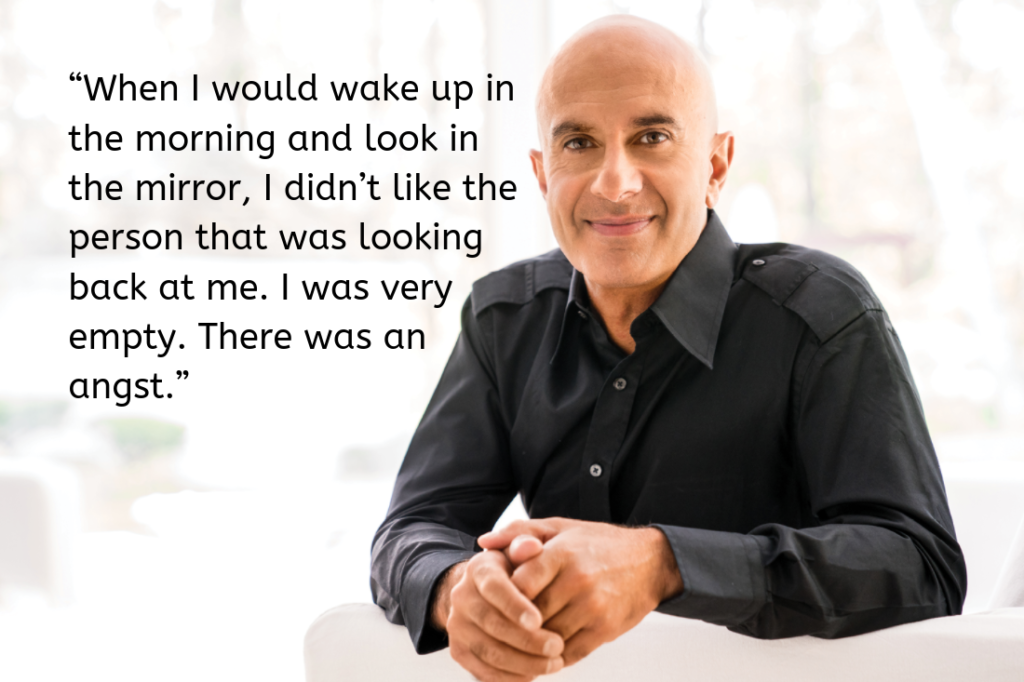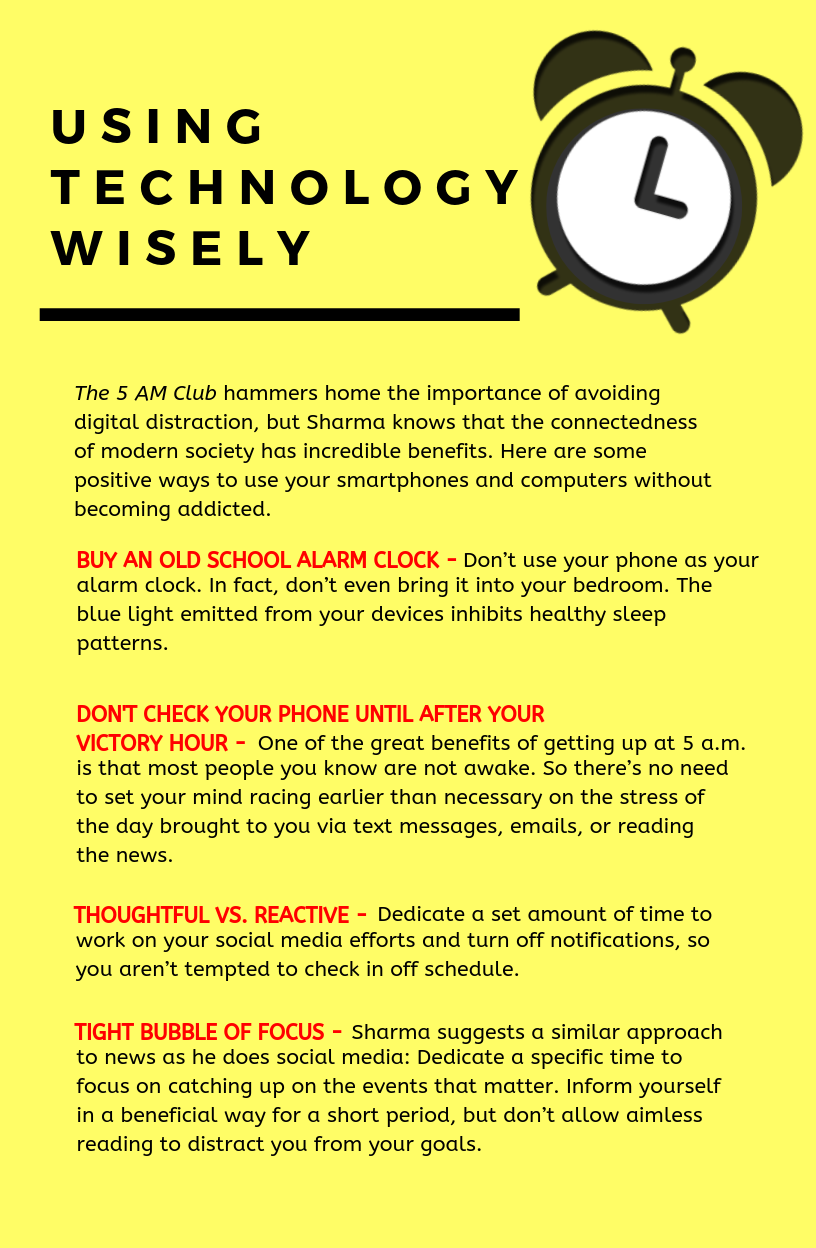Robin Sharma wants me to wake up at 5 a.m. He swears I’ll feel more energized and productive. He tells me that Mozart, Frank Lloyd Wright, and Ernest Hemingway made a habit of rising early.
He promises that if I wake up at 5 every morning and follow his 20/20/20 formula for what he calls a “Victory hour,” my life will change. My creativity is going to soar, my fitness will improve, and I will just generally feel better about myself.
But right now, at 4:58 a.m. on a Thursday, the only thing I feel is tired.
But one motivating factor forces me out of my warm bed: The chance to prove this man wrong.
Sharma, the famous Canadian personal success guru and author of many best-selling books including 1997’s The Monk Who Sold His Ferrari, probably couldn’t care less whether I prove him wrong. But I do.
I blazed through his newest book, The 5 AM Club, in a few days before speaking with him. Told in parable form, the story features four central characters: The Spellbinder, The Homeless Man/Billionaire, The Artist, and The Entrepreneur. Through the course of the book, the Artist and the Entrepreneur go through a complete life change due to the teachings of The Spellbinder and Billionaire characters. The main point of their lessons is, of course, that the two should get up at 5 a.m. and structure their days according to Sharma’s formulas.
I’m not saying that I was cynical about the benefits, but it did all seem a little overstated. I had to test it myself. When the clock hit 5 a.m., I crawled out of bed to begin my day with the 20/20/20 formula that was supposed to change my life.
Where It All Began
Robin Sharma is the son of Indian and Kenyan immigrants to Canada. He says he came from humble beginnings and the immigrant mindset that drives so many high-achievers took root in him from an early age. He graduated from law school and became a successful lawyer at a big firm in Toronto.
“But when I would wake up in the morning and look in the mirror, I didn’t like the person that was looking back at me,” says Sharma. “I was very empty. There was an angst.”
He turned to education, this time studying the lives of the great women and men of the world, looking to understand their tactics and methods to implement those practices in his life. Out of this transformation came his first book, 1994’s Megaliving.
Despite some difficulties as a first-time author, Sharma was able to sell enough copies of the book to begin his career as a speaker, author, and personal success guru. Out of that moderate success, Sharma started to dream bigger. His second book, The Monk Who Sold His Ferrari, caught fire and launched Sharma into global fame.
Suddenly, Sharma was a man in his early 30s speaking to audiences of thousands all over the world. His morning routine and his disciplined life that had been shaped in his 20s were vital to helping him avoid the pitfalls that so many people experience when fame and success come their way.

COURTESY OF ROBIN SHARMA
Exercise, Reflect, Grow
Do you just get up at 5 a.m. and start cranking on those emails before any of your co-workers and competitors? Is that how you get ahead and stay ahead?
Not exactly.
Sharma lays out a detailed routine in the book and claims it’s what has helped billionaires, superstar athletes, and others with whom he’s worked through the years.
Here’s how the 20/20/20 formula is broken down: The first 20 minutes of your day are for sweaty exercise. Sharma’s “Billionaire” character gets deep into the science of why sweating and getting your heart rate up early in the morning are so good for you. In summary, you’ll increase your feel-good dopamine and serotonin levels and kickstart your metabolism while lowering your levels of cortisol, essentially a stress hormone.
The next 20 minutes should be quieter, dedicated to journaling, meditating, planning, praying or contemplating. This should get your mind, heart and soul in the right place for a day that promises to throw all kinds of difficulty and stress your way. Taking this time to be quiet and still will increase your gratitude and your happiness.
While the exercise piece is a pretty specific and, in Sharma’s terms, “non-negotiable,” piece of the 5 a.m. puzzle, the reflection portion allows more creativity for you to do what is most comfortable for you. But one part that Sharma insists should be included in your second 20 minutes is journaling. Writing down your goals, plans, commitments, and the things you are grateful for will shape your day more positively.
The final 20 minutes allow for even more customization. The “Grow” period is left for you to learn whatever it is you feel like learning. So if you want to listen to a podcast about successful entrepreneurs, or read a great book, or work on a language you want to learn, all of that is in play in these 20 minutes. The goal is to stimulate your brain and improve your intellectual capabilities.
Lots of Coffee, Yawning, and Productivity
OK, that’s all well and good. But maybe you are like me. You’re a night owl. Your best work has been completed in the similarly quiet hours of 11 p.m. to 2 a.m.
For every Hemingway the book uses as an example of an early riser, I counter in my head with Winston Churchill, one of the most prolific writers and human beings ever, who would write until 2 or 3 a.m. and stay in bed until the late morning. Surely there are those who are built for the 5 a.m. club, and there are those who are more suited for the night club.
But, to be honest, I haven’t really been as productive late at night as I used to be. In my college years and early 20s, inspiration would strike late, and I’d grab a coffee and crank something out. I once applied to a life-changing job at 3 a.m. However, those days seem to have passed me by. I need a change.
“I slip all the time. I think most people do. Each day is simply about fighting the disruptive currents and getting back on track.”
So, here I am trying to figure out how to use my old-school alarm clock at 4:58 a.m. because following Sharma’s plan means my phone stays in another room. I slink out of bed as my wife, who decided to join me in this experiment, does the same. We don’t say much to each other. Our dogs, excited by the alarm, run into our room with a burst of energy that helps to wake us up a little more. We head into the kitchen to begin our workout. Honestly, it’s easier than I expected. Once the shoes are on and the warm-up begins, I feel as awake as ever.
After the workout, we split up and eat our breakfast while spending our next 20 minutes quietly. We choose to pray, journal, and read our Bibles. This is something we often talk about desiring to do more, but when the stresses of life hit us in the face the second we usually wake up, it’s all too easy to cut 20 minutes of prayer out of the day. We then spend the final 20 minutes reading, learning, listening to things that improve our lives, or working on our side gigs.
The Victory Hour is complete. And now it’s 6 a.m. Work isn’t for a few more hours. Now what?
This is where we found even more benefits. Instead of sleeping through the 5 and 6 a.m. hours, we were now fully awake to take advantage of this extra time. My wife has a home bakery and has been putting in really late hours over the past six months, never having enough time after her full-time job to decorate the cookies that she sells. I’m a writer, and I never have time after work to write the things I want to write. At 6 a.m., we are both able to devote ourselves to these things completely free from distraction.
What I found to be the most vital tenet of The 5 AM Club is the ban on electronic devices. Not in your bedroom, not as your alarm clock, not as the first thing you look at in the morning. No checking emails, or tweets, or Instagram, or text messages. No one should need you at 5 a.m.; the phone and computer can wait until you’ve started your day in the right way. Extending this ban until 7 a.m. proved to be simple, yet magical.
But I don’t want to act like this was a consistent, comfortable, and clean improvement. Every day that we tried to wake up at 5 a.m. was difficult. Sometimes, we just flat-out didn’t do it. We set the alarms and snoozed them and woke up at 7 a.m. But upon reflection, we missed those extra hours in our day.
I asked Sharma if he ever hits the snooze button, or falls off the 5 a.m. wagon and has to get back on target. I figured after 22 years of perfecting his morning routine that he might not even understand the struggles of a new member of the club.
“I slip all the time. I think most people do,” says Sharma. “One time the pilot on a little plane let me fly a little bit, and as I was holding the yoke, I noticed the plane was constantly being pushed off course by the winds. My goal was to make sure that we stayed on course. That’s what happens every single day to every single one of us. There are temptations and distractions that get us off our habits and our priorities. Each day is simply about fighting the disruptive currents and getting back on track.”
Armed with the knowledge that even Sharma slips and oversleeps, it was easier for me to get back on course and join the club again the next morning. I’m not a billionaire or a superstar athlete or Ernest Hemingway, but I do feel more productive, alert, and ready for my day.
Maybe, it’s as simple as not hitting snooze.

This article originally appeared in the September/October 2019 issue of SUCCESS magazine. This article was republished with permission and in partnership with RIZZARR. The author of this article is Scott Bedgood. He is a freelance writer and the author of Lessons from Legends: 12 Hall of Fame Coaches on Leadership, Life, and Leaving a Legacy. He lives in Dallas, Texas, with his wife Sami.








